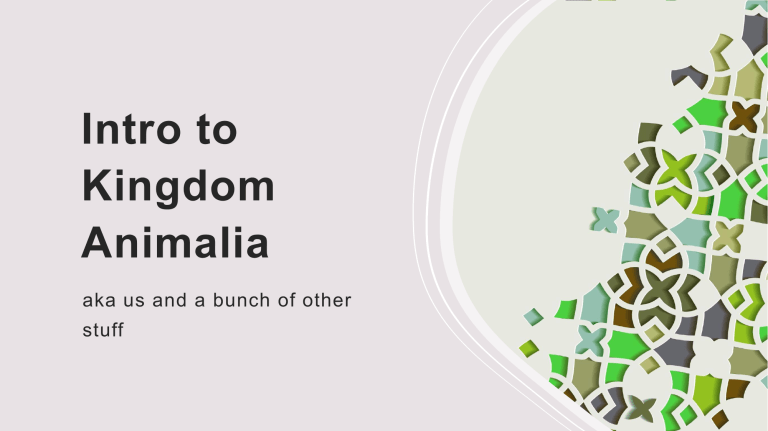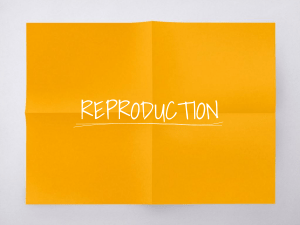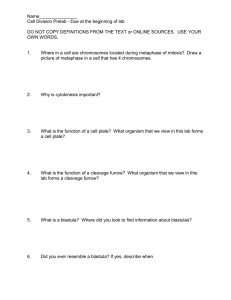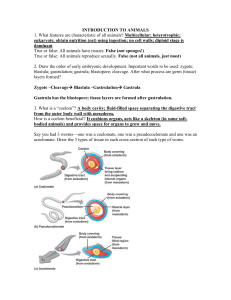
Intro to Kingdom Animalia aka us and a bunch of other stuff First off… • What is an animal? • MAIN IDEA: An animal is a multicellular eukaryotic heterotroph whose cells lack cell walls • Plant + Fungi have cell walls, where animals don’t • Multicellular means division of labour with specialised cells Surviving as an Animal Every animal has to do these things in some way • Feeding • Respiration • Internal Transport (movement of nutrients etc throughout body) • Excretion • Response (to a bunch of stimuli) • Movement (although some are sessile) • Reproduction (mostly sexual, some asexual forms) Body forms and structure • 2 forms of animal, vertebrate (backbone) and invertebrate (no backbone). Vast majority are invertebrate • 3 types of skeleton structure exist: 1: Hydrostatic Skeleton • No hard structures, muscles surrounded and supported by water-filled body cavity – Cnidarians and some worms for example Forms cont. 2: Exoskeleton • Hard outer layer (exo = outer) • Rigid frame to support bodyweight • Protects internal tissue/organs from predation • Usually water-impermeable (prevents water loss) • Ex. arthropods, some shelled mollusks, crustaceans 3: Endoskeleton • Interior framework (endo = inner) • Muscle attaches to outer surface of endoskeleton • Allows for larger bodies • More flexible • Ex. vertebrates (like us), sponges, and echinoderms Skeletons are made of different materials such as: • Calcium carbonate (corals, sea urchin) • Chitin (arthropods and some crustaceans) • Silica (some sponges) • Cartilage (cartilaginous sharks) • Bones (vertebrates like us) Reproduction in Animals Can be Asexual or Sexual Asexual • Fragmentation and budding • Rapid production of offspring from a single individual • Does not provide genetic diversity • Not as common among animals, mostly seen in sponges and cnidarians, and some worms Sexual Reproduction • Large majority of animals undergo sexual reproduction (especially as they become more complex) • Most have separate sexes (male + female) but some are Hermaphroditic (produce sperm and eggs) and can fertilise each other • Forms new genetic combinations which may make offspring more successful • Overall slower reproduction time • Fertilisation can be external (like salmon) or internal (most mammals) Early Development of Animals • After fertilisation, a zygote is formed (sperm + egg) • Zygote divides and becomes an embryo, keeps dividing multiple times until it has 8-cells • At this point, it can follow Spiral or Radial cleavage patterns • Spiral is associated with Protostomes • Radial is associated with Deuterostomes Both of these patterns continue dividing until forming a hollow ball called the Blastula Protostomes and deuterostomes can be separated by their early cleavage patterns, development, and what end the blastospore forms • Determinate development = cells have specific fates early on, so if they die the rest of the cells are altered/development halts • Indeterminate development = all cells can become anything so the loss of one cell does not stop development • Blastopore = folded-in hole formed in the blastula Protostome • Spiral cleavage • Determinate development • Blastopore becomes mouth Deuterostome • Radial cleavage • Indeterminate development • Blastopore becomes anus The Germ Layers • Animals have 3 germ layers, all continue to divide Ectoderm: layer of cells on the outside of the blastula, eventually forms epithelial and neural tissues (skin, hair, spinal cord, brain) Endoderm: layer of cells folded inside the blastula ( inner layer), eventually forms inner lining of digestive and respiratory tract Mesoderm: middle layer between the other two, slightly different between the ‘stomes, forms muscles and body cavity



